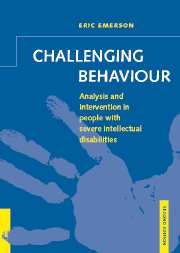5 - The bases of intervention
Published online by Cambridge University Press: 14 August 2009
Summary
In this chapter, some of the general characteristics of current ‘best practice’ in approaches to intervention will be discussed. It will be argued that, wherever possible, interventions, whether behavioural, psychopharmacological or based on alternative approaches, should be constructional, functionally based, socially valid and, of course, ethical.
The constructional approach
Israel Goldiamond, in one of the classic contributions to the development of applied behaviour analysis, identified two broad orientations which characterize most approaches to intervention (Goldiamond, 1974). Firstly, he identified a pathological approach which focusses on the elimination of behaviours (e.g. selfinjury) or states (e.g. anxiety, distress). As he pointed out:
such approaches often consider the problem in terms of a pathology which, regardless of how it was established, or developed, or is maintained, is to be eliminated (Goldiamond, 1974, p. 14).
He contrasted this with what he termed a constructional approach, an orientation:
whose solution to problems is the construction of repertoires (or their reinstatement or transfer to new situations) rather than the elimination of repertoires (Goldiamond, 1974, p. 14).
Take, for example, the case of John, a young man with severe intellectual disabilities who displays aggression when attempts are made to teach him new skills. A pathological approach would pose the question: how can we stop John being aggressive? A constructional approach would formulate the problem in terms of: how can we support John in responding more appropriately to the types of situations which evoke his aggression?
Information
- Type
- Chapter
- Information
- Challenging BehaviourAnalysis and Intervention in People with Severe Intellectual Disabilities, pp. 66 - 74Publisher: Cambridge University PressPrint publication year: 2001
